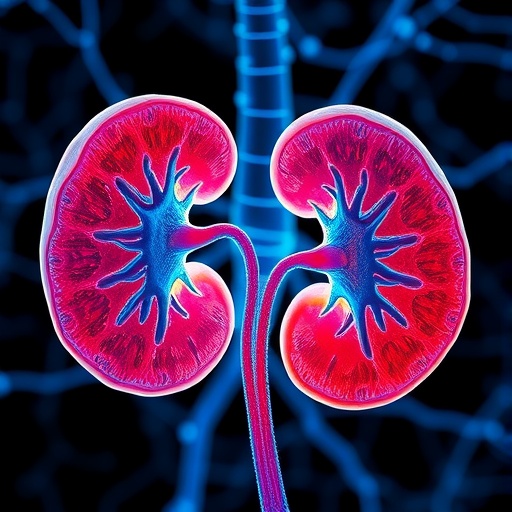PROTECT YOUR DNA WITH QUANTUM TECHNOLOGY
Orgo-Life the new way to the future Advertising by AdpathwayIn the quest for understanding and treating neovascular age-related macular degeneration (nAMD), a significant breakthrough has been unveiled in the landscape of ophthalmic research. Recent findings from a study conducted by Lynch et al. dissects the intricate protein profiles present in the aqueous humor of patients undergoing anti-vascular endothelial growth factor (anti-VEGF) therapy. This work paves the way for novel insights into the biomolecular underpinnings of treatment-naïve nAMD.
The basis of the study revolved around the recognition that nAMD is a leading cause of severe vision loss among the elderly. The condition is marked by the abnormal growth of blood vessels in the retina, which ultimately leads to degeneration of the macula. Anti-VEGF therapies have emerged as a cornerstone in the management of nAMD, though the biological machinations by which these treatments exert their effects were poorly understood until now. The exploration of proteomic profiles can potentially illuminate these underlying mechanisms.
Utilizing state-of-the-art mass spectrometry techniques, the researchers meticulously analyzed aqueous humor samples collected from treatment-naïve patients diagnosed with nAMD. This body fluid serves as a critical source for gleaning information regarding the retinal environment, offering insights that are not only essential for understanding disease pathogenesis but could also serve as a basis for gauging therapeutic responses. The study utilized sophisticated bioinformatics approaches to elucidate alterations in protein expression patterns following anti-VEGF administration.
The results revealed a profound alteration in the proteomic landscape following the initiation of anti-VEGF therapy. Among the differentially expressed proteins, several were noted to align with pathways associated with inflammation and vascular remodeling. These findings indicate that the proteomic response to anti-VEGF therapy does not merely suppress aberrant vascular growth but also triggers a cascade of systemic responses that could mirror the complex biology of the retina. This dual effect may be crucial for optimizing therapeutic strategies to improve patient outcomes.
Moreover, the analysis unveiled novel candidate biomarkers that could potentially serve as prognostic indicators in clinical practice. Identifying specific proteins that correlate with therapeutic success or adaptive responses following treatment could refine patient management strategies and aid in tailoring individualized treatment protocols. With personalized medicine taking center stage in contemporary healthcare, the implications of these findings could be far-reaching.
Interestingly, the study also pointed out the role of immune-mediated mechanisms that could exacerbate or modulate disease progression. The noted interaction between various proteomic entities, particularly those linked to immune signaling, adds another layer of complexity to our understanding of nAMD. Such insights underscore the necessity of considering patient-specific immunological profiles when devising treatment regimens.
In addition to broadening our knowledge of nAMD treatment, the implications of this research extend toward the pharmacological landscape. The proteomic profiles unearthed in this study could advocate for a reevaluation of existing anti-VEGF therapies, suggesting that adjunctive therapies targeting specific pathways revealed by the proteomic data may yield enhanced efficacy. This opens the door to innovative therapeutic strategies that harness the power of combinatorial approaches.
The team’s findings serve as a timely reminder of the dynamic interplay between disease and therapy in nAMD. As the field pivots toward precision medicine, understanding how the neovascular milieu responds to vasculature-targeted interventions remains paramount. By establishing a connection between protein expression changes and clinical outcomes, the groundwork is laid for future trials that may test biomarkers indicative of treatment response.
Furthermore, this research offers hope to the millions affected by nAMD. As the societal burden of age-related diseases continues to rise, uncovering new facets of such conditions is imperative. The pursuit of knowledge in this domain will undoubtedly enhance not only therapeutic efficacy but also the quality of life for individuals grappling with the consequences of age-related degeneration.
As we delve further into the implications of these findings, it becomes evident that ongoing research is necessary to validate the discoveries made in this study. The engagement of a multidisciplinary approach that bridges basic science, clinical research, and bioinformatics will be essential in advancing our understanding of nAMD. As scientists and clinicians collaborate across fields, the potential for innovation in treatment protocols comes into clearer focus.
In conclusion, the work by Lynch and colleagues has set a new standard in the exploration of proteomic changes following anti-VEGF treatment in nAMD. By shedding light on the myriad factors influencing treatment efficacy, this research heralds a transformative era in the management of one of the leading causes of vision impairment in older adults. The concurrent exploration of both the retinal ecosystem and the avenues for therapeutic intervention signals a new horizon in improving visual outcomes for patients afflicted by nAMD.
Subject of Research: Neovascular Age-Related Macular Degeneration and Anti-VEGF Therapy
Article Title: Proteomic profiles in the aqueous following anti-VEGF therapy in treatment naïve neovascular age-related macular degeneration
Article References:
Lynch, A.M., Drolet, D.W., Trinder, K.M. et al. Proteomic profiles in the aqueous following anti-VEGF therapy in treatment naïve neovascular age-related macular degeneration. Clin Proteom 22, 32 (2025). https://doi.org/10.1186/s12014-025-09555-3
Image Credits: AI Generated
DOI:
Keywords: Neovascular Age-Related Macular Degeneration, Anti-VEGF Therapy, Proteomic Profiles, Biomarkers, Personalized Medicine
Tags: advancements in AMD researchanti-VEGF therapy effectsaqueous humor protein profilesbiological pathways in AMDmass spectrometry in ophthalmic researchnAMD treatment biomarkersocular proteomics and therapyprotein profiling in eye diseasesproteomic analysis in age-related macular degenerationretinal disease mechanismstreatment-naïve neovascular AMDvision loss in elderly patients


 3 hours ago
11
3 hours ago
11





















 English (US) ·
English (US) ·  French (CA) ·
French (CA) ·